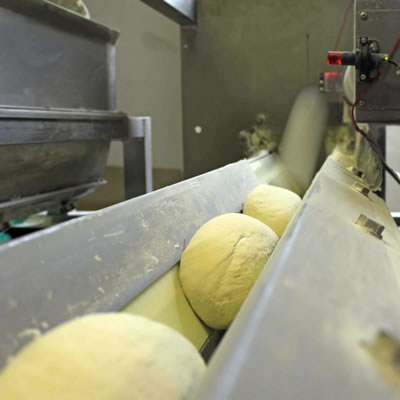
Dough Rounding
What is Dough Rounding?
Dough rounding is the second step in the make-up stage after dough dividing. During rounding, the divided dough piece is shaped into a ball for easier handling, and in some cases, coated with dusting flour to prevent dough pickup in the equipment’s product-contact surfaces, e.g., belt conveyors. This step is between the dough divider and intermediate proofer.
Dough rounding is an essential step in the production of yeast-leavened bakery products such as:
- Buns and rolls
- Pan breads
- Pizza
This operation is sometimes carried out manually in small bakeshops, or mechanically in large-scale production bakeries.
How does dough rounding work?
When the dough piece leaves the divider, it is an irregular shape with sticky cut surfaces that the gas can readily diffuse from. The function of the rounder is to impart a new continuous, smooth outer skin by stretching the gluten on the outside of the dough. This new and consistent layer will be responsible for retaining the gas, as well as reducing the stickiness to increase its handling or machinability.1
Dough rounders intended for high-speed or large-scale production bakeries are equipped with automatic flour dusting equipment. The running speed of dough rounding equipment can be set manually on-place by a human-machine interface (HMI) or centrally pre-set through the SCADA system, to match the running speed of the production line.
Common adjustments during dough rounding include:
- Amount of dusting flour (this variable is a function of dough temperature, hydration level, and rheology)
- Linear speed of belt or rotational speed of cone
- Raceway gap
- Differential belt speed
- Belt speed
- Bar or track angle
- Bar or track length
All these variables affect how properly shaped the rounded balls are. Personnel in charge may opt to check the rounded dough produced and compare it to the standard dimensions.
Equipment used for dough rounding
Conical rounders
The most common type that consists of a cone which is rotated about a vertical axis, with the track of the fixed rounding surface, or runway, located in a spiral pattern about the outside of it. The friction of the dough pieces between the runway and cone surface seals the dough pieces and forms their round shape. The cone of this rounder is inverted and has a grooved surface.2
Belt rounders
It has a belt and straight rounding bar or track set at an angle. The friction between the dough and rounding bar causes the dough to round as it is conveyed on the belt. Belt should be regularly maintained with the bar to prevent excessive sticking to the bar.
V-type rounders
This type of rounder has two belts orientated in a V fashion. One of the belts is driven or run at a higher speed. The differential speed of the belts causes shear and friction. These factors shape the dough and turn the irregular dough into a rounded ball.
Cylindrical rounders
This type of rounder is a variation of the conical rounder. This uses a track around a cylindrical drum instead to shape the dough pieces.
Food safety and quality considerations
- Dough rounding equipment should allow for maintenance, inspection, cleaning and sanitation activities to be performed easily, adequately and quickly.
- Excess dusting flour may create cores in the crumb, and make the dough prone to slippage on rounder’s product-contact surface.2
- As a rule of thumb, a dough that passes satisfactorily through the divider generally will pose no difficulty at the rounder. However, dough that is troublesome at the divider will tend to be difficult to handle at the rounder.2
References
- Bhatia, S.C. “Bakery and cereal products.” Food Biotechnology, Woodhead Publishing India Pvt. Ltd., 2016, p. 165.
- AIB International. Bread Manufacturing Process, Distance Learning Course, “Part 2 Module 02 – Rounding.” https://www.aibonline.org/Start-Your-Training/Baking/Baking-Foundations/Bread-Manufacturing-Process-Online, 2018.

